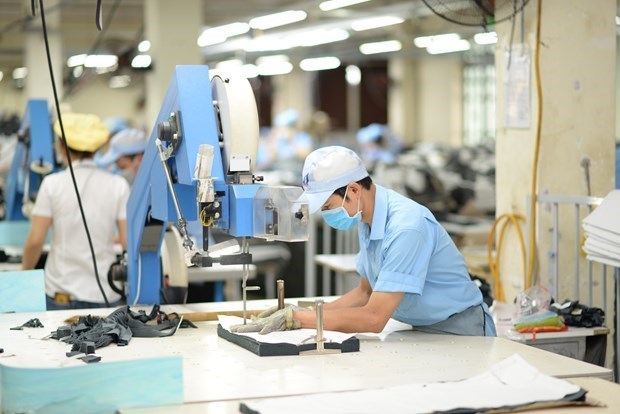ADB bullish on Vietnam's economic growth despite COVID-19 slowdown
 |
| ADB has reduced its GDP forecast for Vietnam but remains optimistic on its post-pandemic prospects |
The country’s economy is expected to grow 3.8 per cent this year and 6.5 per cent in 2022, according to the Asian Development Outlook (ADO) 2021 Update. Growth picked up in the first half of 2021, largely because of higher trade volumes, but slowed down in the second half of the year as the fourth wave of the pandemic took a toll on business and the labor market. Inflation will be muted in 2021 and 2022 due to the slower growth.
“The prolonged COVID-19 pandemic and extended lockdowns have weakened consumption and investment, hampering Vietnam’s growth prospects," said ADB’s country director for Vietnam Andrew Jeffries. “But the Vietnamese economy will bounce back if the COVID-19 pandemic is brought under control by the end of 2021 and 70 per cent of the country’s population are vaccinated by the second quarter of 2022.”
The COVID-19 pandemic is expected to drag down 2021’s growth prospects. The labour shortage caused by the lockdown in the Mekong Delta will disrupt agriculture supply chains. Agriculture exports may also suffer from the monsoon in the third and fourth quarters and the quarantine measures imposed on Vietnam’s agriculture exports. On the bright side, improved market access from free trade agreements and recoveries in the European Union, the People’s Republic of China, and the US will boost agricultural exports. Agriculture growth is expected at 2.7 per cent in 2021, the same level as in 2020.
Extended lockdowns in major cities will continue to disrupt the supply of labour, hurting especially labor-intensive manufacturing and lowering output, the purchasing managers' index, as well as weakening consumption and investment, and slowing the disbursement of public investment.
The fast recovery of Vietnam’s main overseas markets, particularly the European Union, the People’s Republic of China, and the US, will support exports, especially for textiles, garments and footwear, electronics, and mobile phones. But the lockdown of major industrial hubs in the Mekong Delta will constrain production capacity, triggering a shift of orders to other countries, as 18 per cent of European companies doing business in Vietnam already did in July and August. The small increases in foreign direct investment (FDI) flow and disbursement in July and August are unlikely to continue over the rest of the year because of factory closures and labour shortages.
The Update revised down the GDP growth forecast to 3.8 per cent in 2021 from the 6.7 per cent projection in ADO 2021. Assuming the COVID-19 pandemic is brought under control by the end of 2021 and full vaccination covers 70 per cent of the population by the second quarter of 2022, the growth forecast for next year is revised to 6.5 per cent, which is still lower than the earlier projection. The inflation rate forecast is also revised down to 2.8 per cent for 2021, as subdued domestic demand has pushed the rate to its lowest level since 2016. The inflation rate is forecast at 3.5 per cent in 2022 as growth accelerates.
The deterioration in the external current account this year and next is expected to be worse than ADO 2021’s forecasts. A modest current account deficit equal to 1.0 per cent of GDP is expected in 2021 since the impact of the pandemic on production will slow export growth over the rest of the year. The current account is expected to return to a surplus, at 1.5 per cent of GDP in 2022, as exports increase on a revival in domestic production and external demand.
Vietnam’s economic outlook in the near term is challenging. The main risk to the outlook is a prolonged COVID-19 outbreak if the vaccination rate does not increase substantially. Because vaccines are not reaching Vietnam fast enough, the government’s efforts to start up domestic COVID-19 vaccine manufacturing in 2021, combined with increased procurement from outside sources, will be crucial for the country to avert a health crisis caused by the pandemic.
The growth prospects for this year and next will also depend on the timely and sufficient provision of necessities, such as food and cash, to those affected by the outbreak. Nonperforming loans could become a risk in 2022. Cutting unnecessary administrative burdens and digitalising government procedures will be critical for improving the efficiency of pandemic containment measures and to support recovery this year and next.
Vietnam can benefit from removing administrative hurdles to business and people, and accelerating digital transformation, which will help improve the efficiency of pandemic containment measures and support a sustainable economic recovery this year and next.
What the stars mean:
★ Poor ★ ★ Promising ★★★ Good ★★★★ Very good ★★★★★ Exceptional
 Tag:
Tag:
Related Contents
Latest News
More News
- Businesses ramp up production as year-end orders surge (December 30, 2025 | 10:05)
- Vietjet chairwoman awarded Labour Hero title (December 29, 2025 | 13:06)
- How to unlock ESG value through green innovation (December 29, 2025 | 10:03)
- AI reshapes media and advertising industry (December 29, 2025 | 08:33)
- FPT and GELEX sign deal to develop blockchain tech for global markets (December 29, 2025 | 08:29)
- Vietnam’s GDP forecast to grow by 9 per cent in 2026 (December 29, 2025 | 08:29)
- Women entrepreneurs are key to Vietnam’s economic growth (December 29, 2025 | 08:00)
- Vietnam's top 500 value-creating enterprises announced (December 27, 2025 | 08:00)
- The PAN Group shaping a better future with ESG strategy (December 26, 2025 | 09:00)
- Masan Consumer officially lists on HSX, marking the next phase of value creation (December 25, 2025 | 13:20)




























 Mobile Version
Mobile Version